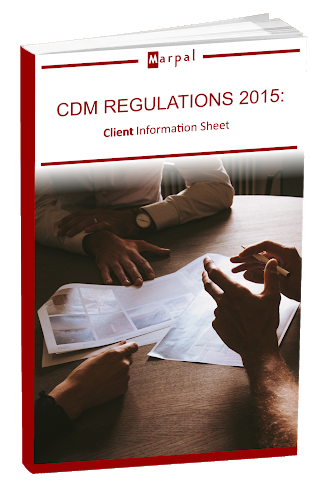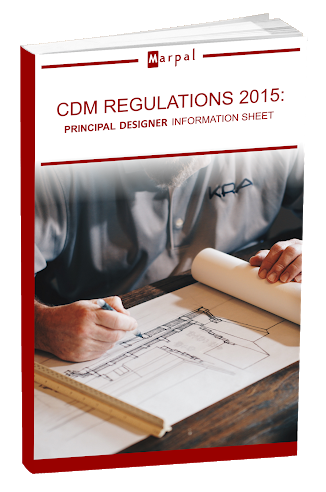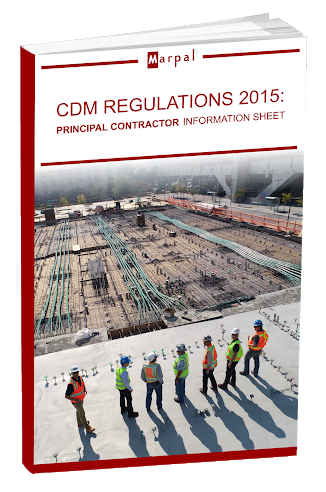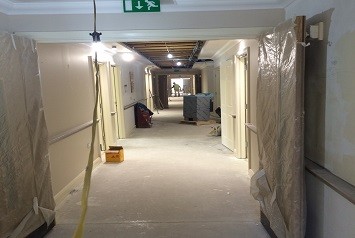
This article looks at some of the key health and safety considerations when carrying out refurbishment works within Care Homes, however, it is not intended to be inclusive of all potential issues, which may be encountered.
When considering whether to have refurbishment works undertaken within your Care Home, it isn’t as straight forward as arranging for a builder to pop round, provide a quote and then fix a start date. There are a number of things you must consider to ensure the health and safety of your residents, staff and Contractors. The main piece of legislation which imposes specific duties is the Construction (Design & Management) Regulations 2015, or CDM for short; this is discussed later in the article.
Competence
When we talk about competence, we are not describing the quality of workmanship. We are referring to the Contractor’s ability to plan, manage, monitor and coordinate their works without jeopardising anyone’s health and safety.
Under the CDM Regulations, Clients are required to appoint competent Contractors. It is essential to check that the Contractor you are looking to appoint has the knowledge and experience of working within the Care Home environment. It’s important that the Contractor understands the risks involved and how these are overcome and dealt with.
Communication
It seems obvious but the failure of projects can simply come down to poor communication. Good effective lines of communication are essential for ensuring that your refurbishment project runs smoothly with minimal disruption.
The Care Home Manager and their Management Team must ensure that regular meetings are held with the appointed Contractor. This can be as formal or informal as you like, but the key here is that both parties are talking and communicating with each other. This will allow the Home Manager to understand what works are being planned and where, when and what impact this may have on the running of the Home. Also, the Contractor may be informed that they are unable to work in certain areas of the Home due to planned activities or unforeseen circumstances.
Lines of communication should extend to your residents as well as their families. This can be achieved by holding an open meeting so that families understand why the works are being undertaken and the impact this may have. Regular updates can also be sent to residents and their families. A great means of keeping everyone up to date and informed is a notice board within the reception area or entrance foyer.
Segregation
Carrying out refurbishment works within a live occupied Home, with residents who may be physically impaired or suffer with dementia can prove to be difficult and challenging. Minimising the interface and interaction between parties is essential. It may be difficult for the Contractor to provide segregation, but this must be achieved as far as is reasonably practicable. The closure of wings, or closing off corridors, or floors to create working areas should be carried out where possible. Be aware of blocking fire escape routes and Fire Risk Assessments should always be reviewed. In addition, rooms should be closed off with physical barriers and signage used.
It is useful to get the Contractor to produce a Phasing Plan, which can identify the areas of the Home being worked on and the means of segregation. Identifying this on a drawing or plan is far more comprehendible.
Logistics
When planning your refurbishment project, you should always look at the site logistics. A Site Logistics Plan should be developed with the appointed Contractor. The Plan should describe the agreed access and egress routes onto the site and into the Home. Where possible, Contractor’s access/egress routes should be segregated from those used by the Home. Other items to consider should include: –
i) Contractor parking and deliveries
ii) External and internal storage areas
iii) Welfare facilities for the Contractors workforce
iv) Sanitary provisions for the Contractor
v) No-go areas
vi) Fire escape routes and assembly points
The Logistics Plan should be regularly reviewed and updated as the project progresses and the arrangements change.
Practical Issues to Consider
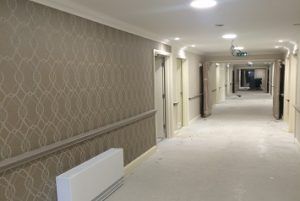 Residents – Consideration should be given to the movement of residents. This can be challenging where residents are elderly or bedbound. Other residents may become confused and anxious and those with challenging behavior may become abusive and aggressive.
Residents – Consideration should be given to the movement of residents. This can be challenging where residents are elderly or bedbound. Other residents may become confused and anxious and those with challenging behavior may become abusive and aggressive.
Tools and Materials – Intentional or unintentional self-harm may be caused from tools or materials being left unattended.
Residents Rooms – Actual works shouldn’t be undertaken in occupied rooms, however, access may be required when planning for works to be undertaken. Only Contractors accompanied by members of staff who are familiar with the Resident should access their rooms.
Control of Access and Egress – Contractors must not wedge or leave doors or gates open. Residents are often vulnerable and for whatever reason (dementia, confusion, learning disability etc.), may be unable to appreciate the risk to themselves from falling from height when accessing stairs or other potentially unsafe areas (either at ground floor level or above) and require containment in safe areas of the Home or its grounds for their own personal safety.
Hot Works – Fire safety is of the upmost importance, particularly as residents sleep on the premises and even more so, due to their vulnerability. Hot works should be avoided, however, where this is impractical a Hot Works Permit system should be implemented.
Care Home Induction – A health and safety induction should be given by the Home Management to the Contractor. The key points identified within the induction can then be incorporated within the Contractor’s Site Induction delivered to their Operatives.
Site Rules – Consider the dos and don’ts, the no-go areas and the rules that need to be imposed on the Contractor; this could form part of their Construction Phase Plan, Site Induction or could be displayed within the Contractor’s site welfare area.
Site Safety Inspections – Consider site safety inspections of the Contractor’s activities to ensure that health and safety arrangements are suitable and there are no unsafe practices being undertaken that may jeopardise the health and safety of your residents, staff and visitors.
Other considerations
CDM Regulations 2015
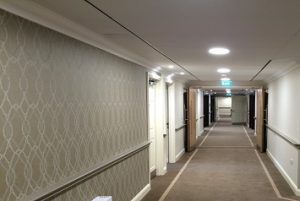 Where there is likely to be more than one Trade Contractor involved in the project, the CDM Regulations require Clients to appoint a Principal Designer to coordinate the health and safety aspects of the pre-construction phase and also a Principal Contractor to coordinate the health and safety aspects of the actual works themselves. Failure to make these appointments will result in the Client taking on these duties by default.
Where there is likely to be more than one Trade Contractor involved in the project, the CDM Regulations require Clients to appoint a Principal Designer to coordinate the health and safety aspects of the pre-construction phase and also a Principal Contractor to coordinate the health and safety aspects of the actual works themselves. Failure to make these appointments will result in the Client taking on these duties by default.
The Principal Designer tends to be the Designer who is in control of the design. If there is some significant design work on your project, such as an extension or internal alterations, you may have appointed an Architect who may be able to take on this role. However, in many instances where Care Homes are being refurbished, there are no Designers appointed. Scopes and schedules of work tend to be developed by the Home Manager or through their Estates Department. Quite often in these instances the Care Home Manager, Estates Department or Care Group take on the role of Principal Designer and then appoint a CDM Consultant to fulfil these duties on their behalf.
When making appointments, it is important to appoint the right individuals or organisations at the right time to allow those appointed to plan and consider the health and safety aspects of the project.
As a Client, you must ensure that you provide pre-construction information to the Principal Designer, notify the Health and Safety Executive (if notifiable), check that the Contractor or Principal Contractor’s Construction Phase Plan has been suitably developed and ensure that the Principal Designer and Principal Contractor comply with their duties; either in house or external advice will be required in fulfilling these duties.
The Control of Asbestos Regulations 2012
If your Home was built prior to the year 2000, it is possible that Asbestos Containing Materials are located within your Home. As the Responsible Person for the premises, the Regulations state that you must have an Asbestos Management Survey.
The purpose of an Asbestos Management Survey is to locate, as far as is reasonable practicable, the presence and extent of any suspected Asbestos Containing Materials (ACM’s) in the building which could be damaged or disturbed during normal occupancy, including foreseeable maintenance and to assess their condition. The survey should form the basis of your Asbestos Management Plan, which must be made available to the Contractor carrying out your refurbishment work. This will allow the Contractor to manage their works and avoid unintentionally releasing any asbestos fibres.
Please be aware that, where there are intrusive works that are likely to disturb the fabric of the building, then you will need to commission a Pre Demolition/Refurbishment Asbestos Survey.
The Regulatory Reform (Fire Safety) Order 2005
Once complete, if your refurbishment project involved building an extension, internal alterations to the layout of your Home or you have changed the type of residential care provided, you will need to review and update your Fire Risk Assessment and your Fire Evacuation Plan. Fire Safety is a specialism and unless you are competent, you should always seek advice.
Posted by: Paul Littlewood BSc (Hons) IMaPS, Managing Director
Should you require any assistance, or further information on Refurbishment Projects, please contact Paul Littlewood at [email protected] or telephone 01332 668877.



